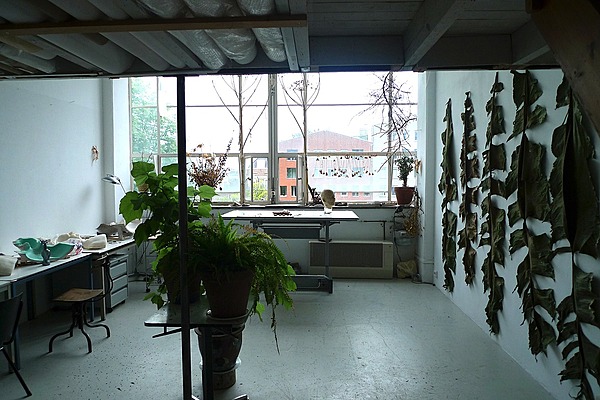English
An interview with Ina van den Heuvel
Flowers as a second skin
By means of the crowdfunding project Corpus Florens Ina van den Heuvel wishes to bring a dream to fruition: the creation a complete body of dried flowers and leaves with the help of a professional mould.
During our interview Ina van den Heuvel gets up regularly to illustrate her statements from the objects on display in her studio: the mould of a head, the dried leaves of a banana palm, a floral sculpture, an object of rosin – the substance that she uses to reinforce her sculptured masks and heads. The bright working space breaths the spirit of craftsmanship.
Why the change from masks and heads to a complete body? ‘I noticed that some natural materials do not lend themselves for the creation of faces. They leave just too big a mark on the final result. But the large banana leaves on that wall, for example, can be processed far more easily if you are working on a complete body. So, little by little I got enthusiastic about the idea of flowers and leaves as a second skin.’
Ina created her first mask thirty years ago as a final project for the Academie Minerva in Groningen. ‘I created a mould of my own face with plaster. You are completely cut off from the world around you for at least an hour. Being wrapped up in a cocoon of plaster, you have to breathe through straws. That is an alienating experience. You have to trust that people will respond to pre-arranged signals.’
Bringing together the human body and nature has been the connecting thread of her artistic calling ever since. In those days wax and stone were her base materials. ‘I had been inspired by Harry Mulisch’ magic-realistic novel ‘Wat gebeurde er met sergeant Massuro’ (Whatever happened to Sergeant Massuro). It tells the story of a person who feels more and more rigid and heavy in the dense jungle of New Guinea. In the end he petrifies and turns into a leaden block of granite. The earth literally cannot support him any longer. It struck me as a striking story about how people can become numb, hardened. In this particular case about the indifference of a colonizer towards the indigenous population.’
So this gave you the idea for a link between stones and humans? ‘At the time one could also notice a hardening of our society. Stones can be the symbol of solidified emotions. According to Jung, stones represent the souls of the deceased. Every separate stone, however, originates from liquid materials. Through extreme pressure in combination with the interval of time materials turn into stone.’
Photography has always been at the heart of your work. ‘I found that photographing heads and stones could produce rather peculiar results. Especially in combination with a printing technique such as heliography. Especially for this photographical process, I had a printing press made that could sustain extreme high pressures. You see, I wanted to work with large copperplates. A regular press could not sustain the accompanying pressure. The work was physically very tough, and sometimes it would take weeks before a print came of the press that gave me total satisfaction. My gravel portraits of people date from the same period. If you gaze at them long enough, the stones will appear to be breathing.’
Why the change from stones to flowers? ‘I had enough of the weight of it all. And I also wanted to engage in my love for flowers. Thus the idea came about to photograph people with flowers. And then I tried to imagine what would happen when the flowers that I collected would take on the form of a human being, in the sense of a second skin. You cannot bring people and nature more closely together than that. Stones could never provide a second skin. At first I started making sketches. Apart from the technique, the process did not differ much from the process of heliogravures. At times I would work one or two months at one drawing. I constructed them layer by layer, and there could be ten to fifteen layers in all. The construction and character of the drawings and the heliogravures were very much alike, although the drawings were a bit lighter. They had an introvert, almost contemplative character.’
And after the drawings the sculptures turned up? ‘I figured, I have to go one step further and try to create shapes with dried leaves and flowers. What would happen if a flower really becomes a face… Around the same time the old mould of my own face resurfaced. My ongoing search for materials gained momentum. Wherever I went, I collected flowers and plants; outdoors during hikes and bicycle trips, but also at flower markets. In the meantime I gained the necessary experience with numerous drying techniques, such as preserving plants and flowers between sheets of paper, under pressure, by dehydrating them in an oven, by applying salt, or just by suspending them.’
And in the end this passion for experimentation resulted in a mask. ‘Yes, a kind of mask. And then I wanted to be able create a complete head, which I managed to do within two years. The main obstacle was the fragility of the materials. I have been looking for ages for a binding agent that could provide sufficient solidity, and that would not be present in a too manifest way. That is how I ended up with synthetic resin. I found out that I would have to construct my creations layer by layer – just as before with the heliogravures and the drawings. The heads I make consist of three, four, five, six, and sometimes even more layers. And thus individual flowers and plants are being transformed into vanitas images, solidified matter.’
And now, in the foreseeable future, a complete floral body, a Corpus Florens, for which a costly mould of six pieces has to be made. ‘Nowadays machines can scan your body, but I do not want that by any means. The mould has to come into contact with the skin. And for me the artisanal aspect comes into play too. And yes, indeed, I want it to be a cast of my own body. To my mind, there will then be no limitations to the things I can do with the mould or to materials that I will use. Furthermore, the creation of such a body mould is quite an invasive experience. Parts of the body are refrained from oxygen. You cannot do that to someone else,’ concludes Ina van den Heuvel smiling.













